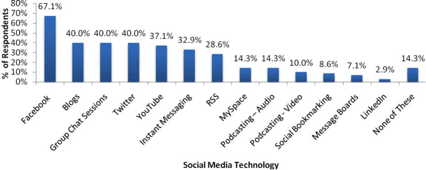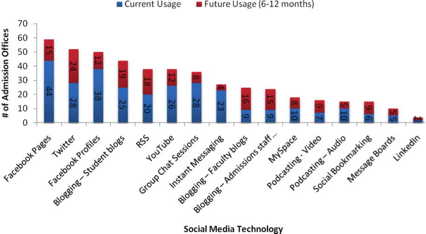We know a lot about teens and their adoption of technology from Pew Internet and elsewhere. And we know a lot about how teens use technology in selecting a college. [Start with Lougan Bishop’s post on Eduguru and explore two of his sources: “E‑Expectations 2010 – Focusing You E‑Recruitment Efforts to Meet the Expectations of College-Bound Students by Noel-Levitz and “Stamats – TeensTalk 2010”].
Getting a glimpse of how admission and enrollment offices use social media is easy, but getting a comprehensive view is much harder. This blog post shares some insights on what I learned while doing some research on this topic for our white paper, “Succeeding with Social Media.”
Some general perspectives
According to NACAC’s “State of College Admissions 2010” report, the use of social media tools continues to grow:
In 2009, 73 percent of respondents reported that they provide links to their colleges’ social networking sites (up from 39 percent in 2008), and 61 percent reported offering blogs by current students (up from 51 percent in 2008 and 42 percent in 2007). Some colleges and universities also have blogs by admission officers (31 percent), podcasts (31 percent) and online message boards …
NACAC also reported that 36 percent of colleges allowed applicants to check their status on the institution’s website. NACAC did not capture data (or did not report data) about the use of Facebook or other social networking sites in college admission.
Nora Ganim Barnes and Eric Mattson claim that higher ed lapped commercial entities in the adoption of social media tools. They found that 51% of colleges and universities have an admission blog and noted that “familiarity with social networking has jumped from 55% reporting they were very familiar with it in 2007, to 63% in 2008 and now to 83%. Admission officers have clearly embraced Facebook and other social networking sites as viable forms of communication with their constituency.” They report that 50% of respondents believe that social media is “very important” to their future strategy (interestingly, a 5% decline since the question was asked in 2008).
BlueFuego staff visited 1,387 colleges and university websites repeatedly over the past two years. They viewed institutional home pages and the opening pages of admission and alumni sites, and recorded when the institutions linked to social media sites from these key pages.
In March 2009, 8.2% of institutions displayed “social web callouts” (BlueFuego’s term for icons or specific links to destinations on the social web such as Facebook, YouTube, Flickr, etc.). Of the 113 institutions that used these links on their admission sites, 64.6% linked to Facebook, 24.8% linked to YouTube (with 18.6% embedding a YouTube video), 14.2% linked to Twitter, and 11.5% linked to MySpace.
Fast-forward to July 2010, when 53% of admission websites included social web callouts (links) on their main pages.
BlueFuego observes, “Admission continues to lag behind in promoting their presences via SWCs directly on their site. Our supplementary research with prospective students has shown that they are more likely to visit and join presences that are officially promoted by the institution.” When the research was done (June 2010), 93.6% of institutions linked to Facebook; 67.2% to Twitter; and 53.3% to YouTube.
A more nuanced view
Abe Gruber’s master’s thesis, “Social Media in Undergraduate University Admissions,” provides the most nuanced view of the range of social media used in admission offices and provides a perspective of how admission office use of social media compares to what prospective students want. Completed in late 2009 the thesis relies upon a sample of 200 prospective students and 70 admission offices. His admission office respondents indicated that Facebook was the most popular social medium used to communicate with prospective students (67% used it); 40% used blogs:

Here is what Gruber’s respondents in admission offices reported about the social media they were currently using, as opposed to what they intended to implement in the next 6–12 months:

Gruber learned that 78.3% of admission offices did not have a strategy regarding the use of social media technologies and that 96.7% of them did not have specific recruitment goals for their social media activities. One of Gruber’s key recommendations for admission/enrollment offices was adoption of a social media strategy:
Since 78.3% of admission offices don’t have an official strategy for their usage of social media, it is evident that not enough time and attention is being devoted to social media as a recruitment tool. As admission offices report that it is “difficult to find the time” for social media, it is common to find situations where there is only one or two people in an entire admission office working with Facebook and blogs. If more effort was devoted to social media in an official capacity, admission offices would become more aware of their own disconnects, and they could do a much better job of actually incorporating social media into their recruitment plans and objectives.
-
Michael Stoner Co-Founder and Co-Owner Was I born a skeptic or did I become one as I watched the hypestorm gather during the dotcom years, recede, and congeal once more as we come to terms with our online, social, mobile world? Whatever. I'm not much interested in cutting edge but what actually works for real people in the real world. Does that make me a bad person?